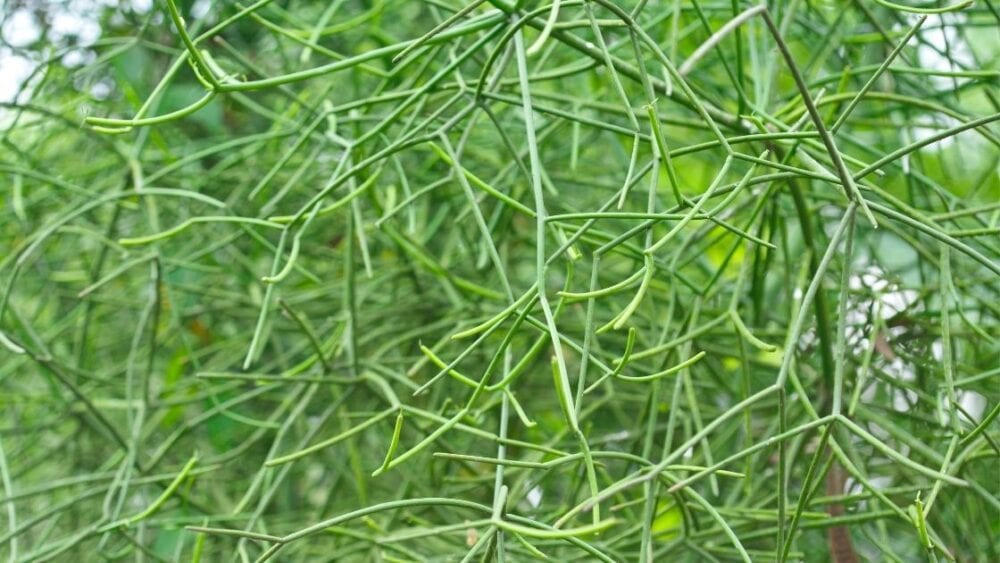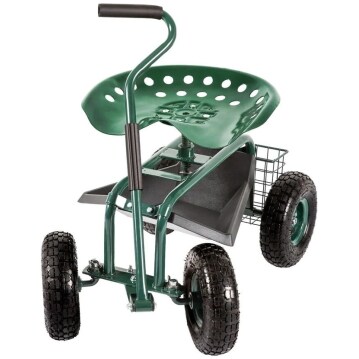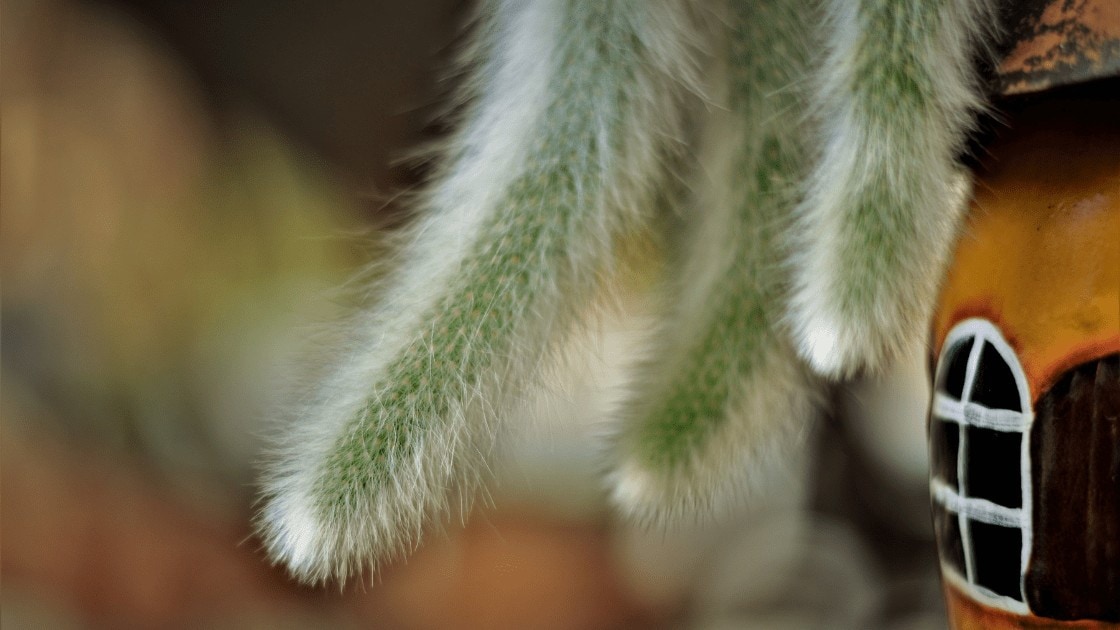
The pencil cactus (Euphorbia tirucalli) is one of the many commonly cultivated succulents in the Euphorbia genus. All succulents in this genus have very similar growth requirements and most come from South Africa. This is one of the largest succulents – it reach up to 7 feet in house conditions. In the wild, it grows into large, 30-feet tall tree. When severely stressed, this succulent may start drooping or wilting. In the following paragraphs, we’ll take a look at the causes of this problem and will see what steps need to be taken in order to fix it. Let’s get started!
What Can Cause a Pencil Cactus to Start Drooping?
Drooping and wilting are common in most thin-stemmed succulents like the pencil cactus – the problem is usually caused by various stresses. Root issues can cause severe, slowly-worsening wilting. The most common cause of wilting is chronic overwatering. Let’s take a quick look at the various causes of drooping in this succulent:
Overwatering

This the most common cause of wiling. The pencil cactus can actually adapt to a more frequent watering regimen and will put out more ‘true leaves’ in more humid environments.
Browse our Affiliate Products
However, this adaptation occurs only when the soil humidity levels increase gradually, over a period of a few weeks. Watering more than 3 consecutive times during a period of 1 to 2 weeks will usually lead to suffocation of the root system and root rot will set in.
The solution is to water less frequently. This cactus usually successfully recovers from symptoms of overwatering regardless of how severely damaged it looks – it can keep photosynthesizing even with one small surviving stem. Recovery from overwatering can be aided by daily misting and cutting back of any dying branches. The symptoms of overwatering also commonly include yellow or gray discoloration and general ‘mushiness’ of the stems.
Root issues
Root issues usually develop because of overwatering, but a compacted soil can also be to blame. If the wilting is severe and steadily worsening, repotting in a more suitable soil is often the best solution.
Heat stress
This is a thin-stemmed succulent, which can lose water much quicker than other succulents. This is especially true if it has put out many true leaves on its stems.
The symptoms of heat stress are easy to recognize by their development – the wilt always starts soon after the succulent is exposed to direct sunlight or placed close to a space heater. After removal of the heat source, recovery is quick.
Lack of light
Large specimens, purchased form a nursery will be dependent on a certain amount of light to transport water and nutrients to their tall stems. When suddenly placed in a light deficient, indoor space, wilting of the higher branches can start to occur. Giving the plant more light while lightly misting once a day will lead to recovery in less than 72 hours.
Over-fertilization or mineral buildup
A buildup of fertilizer salts or calcium from tap water can harm the roots and lead to wilting. Flushing of the pot with large amounts of water solves the issue and the plant will recover in about a week.
Other Causes of Wilting In a Pencil Cactus
Sometimes, the problem cannot be diagnosed accurately and occurs without any obvious cause. Issues with the winter dormancy or a combination of several compounding factors may be causing this.
Insect pests can also cause drooping when they start feeding on the vital juices of the plant. Those are very easy to spot on a sparse-growing plant like the pencil cactus and can be killed with an alcohol spray.
Ways to Correct Wilting and Drooping In Pencil Cactus Plants
Wilting in a pencil cactus almost always has very basic causes, and reviving it comes down to providing the plant with proper watering, sunlight and soil. Short-term ‘band-aid solutions’ may be necessary in severe wilting – those include misting and temporarily placing the succulent in a cool, shaded spot.
Helping your pencil cactus recover from overwatering
The first thing to do is to start watering more infrequently and letting the soil dry up a bit. As it dries up, air will enter the root zone and the roots will resume proper ‘breathing’. If root rot has set in and the root system is too damaged, this may not be enough to solve the problem and repotting is the next logical step.
In severe cases, reducing the water loss through the leaves and stems while the plant recovers is the only way to prevent necrosis of the top growth.
The three ways to do this are
- Using a humidity dome
- Misting daily and
- Cutting back the cactus to reduce its leaf/stem area.
Keep in mind that misting should be done very lightly and not too frequently – otherwise, it can cause more problems than it solves.
For more information on misting plants, check out this article. Misting Plants – Pros, Cons, and How Does It Work?
Dealing with other causes of wilting
Make sure that the wilting is not caused by a poor, compacted soil. This requires some intuition and experience to determine. When in doubt, repot the plant in a more airy soil anyway. Moving the plant to a different, more bright spot is a great, all-around solution to many hard to diagnose problems. You can also play around with the fertilizer regimen and try flushing the soil with excess water to remove any accumulated salts.
Reviving a Dead Pencil Cactus
Even severely-wilted or damaged pencil cactus specimens will usually recover and start putting out new growth eventually. There aren’t many specific revival steps you can take, apart from giving the plant plenty of light, repotting in an airy soil and having a lot of patience. If you’ve cut back your cactus because of how much it has wilted, don’t throw away the cut branches – you can root them in a small pot.
To read more another variety, check out this article. Sticks on Fire Plant Not Growing Properly? Here’s Why
General Care Requirements for Pencil Cactus Plants

The pencil cactus is very easy to care for and as long as you provide it with its basic requirements, you won’t run into any issues. This plant likes infrequent watering, plenty of direct sunlight (filtered through a window is fine) and some occasional repotting or cutting back. Using a very airy, cactus soil, that doesn’t retain a lot of water is extremely important.
Sunlight requirements
Without any direct sunlight, this cactus will not grow much. More colorful pencil cactus varieties, like ‘Sticks on Fire’, will lose their bright coloring in the absence of direct sunlight.
Ideal watering frequency
As a general rule, do not water more than once every 2 weeks.
This rule does have exceptions and the best way to accurately gauge the water needs of the plant is to observe the moistness of the soil surface or the weight of the pot – give the succulent at least 3-4 days of complete drought before watering again.
Winter dormancy
In its natural habitat, this cactus experiences temperatures of around 42F (6C) during the winter, which causes it to go dormant and completely case any photosynthetic activity. In a home setting, this can also occur near a cold windowsill.
Overwatering during this dormancy period is a common mistake that can be fatal to the succulent. Some growers like to skip the dormancy period altogether – in this species, this is unlikely to lead to long-term problems.
The Unique Photosynthetic Abilities of the Pencil Cactus
This cactus has some interesting characteristics, not commonly seen in succulent plants. It can put out tiny leaves, which photosynthesize using the C3 pathway. This is the ‘non-succulent’ type of photosynthesis, which enables very quick accumulation of sugars – this means that in certain conditions, this cactus can grow much faster than other succulents.
However, not all specimens of this cactus will put out those leaves – some will just form stems, which photosynthesize using the CAM process, common in all succulents. When grown from seed, the pencil cactus will always develop leaves, but they will fall off in arid conditions.
Whether or not those leaves come back usually comes down to chance and some varieties may never grow them.
Final Thoughts
The pencil cactus is easy to care for – because of its sparse growth, pests are easy to spot and so is stem discoloration caused by overwatering. Overwatering and lack of light are the most common causes of wilting and an unhealthy appearance.
Accurate diagnosis of the problem is not necessary in order to solve it – instead, focus on giving the cactus plenty of light and a good drought period in-between each watering. If the soil seems compacted, doesn’t drain well or the pot seems too heavy, repotting in a more airy soil may be a good idea.











